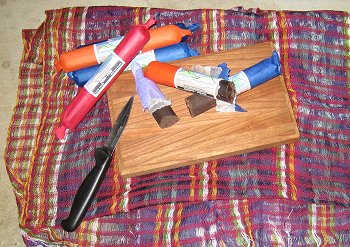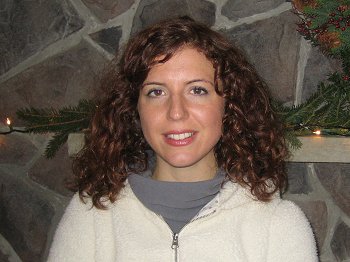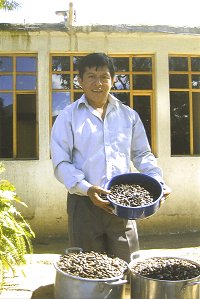- By Dan Veaner
- Around Town
 Print
Print
Question: What does Lansing, New York have in common with Santa Barbara, California?
Answer: They are the only two places in the United States where you can get Diego's Chocolate, a unique, healthful treat made by hand in Guatemala.
If you think that bit of arcane trivia is interesting, the story of how the chocolate got here is even better. It involved joining a circus, and an unexpected Guatemalan journey that compelled two American women to solve a sweet mystery, and unexpectedly landed them in an international import startup that immediately turned a home based business into a world venture.
"It would connect us with Guatemala, which we are both in love with," says Lansing native Beth Hinderliter, who has partnered with circus colleague Lisa Han to sell the chocolate in the States. "I always told myself that I would go back, but I had no clue it would be with the circus or that I would be selling chocolate."

Diego's Chocolate comes hand rolled in tissue with
labels depicting Lake Atilan drawn by children
After graduating from Lansing High School Hinderliter studied theater in college, and moved to Los Angeles to try out film acting. After deciding she prefers live performance, a friend called to tell her about an underground circus based in a warehouse in downtown LA. She attended a rehearsal, and found herself part of the circus without having intended to join.
Growing up in Lansing she had gone with the Lansing United Methodist and All Saints Catholic Church mission to build houses for civil war widows in San Lucas Tolliman , one of the many towns around Lake Atitlan in Guatemala. Hinderliter fell in love with the country, but didn't return until the Lucent Dossier Vaudeville Cirque in which she performs scheduled a tour there. After she joined the circus they wrote a grant for its 'Cuddle The World' program that would send performers to different countries to perform for children suffering harsh living conditions. When inexpensive tickets to Guatemala became available, Hinderliter was excited about the prospect of returning. But she had no inkling of what was in store.

Beth Hinderliter
The circus performed at orphanages and a circus school on Lake Atitlan that takes in homeless children and teaches them how to perform so they can go on the street and make their own money. Between performances she and Han explored the towns. "They were selling these little bright packages at the local restaurants and tiendas," she recalls. "They looked like rolled up cigars, but to me they looked like perfect stocking stuffers. So I tasted one and I flipped out. I said, 'Who makes this?!' And I had my friends try it. Lisa and I were buying them for everybody. 'Try this, try this, try this flavor!' There were sixteen flavors, so we tried all of them."
The pair determined to find the maker of the chocolate. They assumed there was a chocolate lady somewhere nearby, and they asked anyone in San Marcos who would listen who made the chocolate. They were told to go to San Pedro and somebody would probably know. "We went there and asked, and one of the tuk-tuk drivers said, 'Sure, I know where he lives,'" she recalls. "He took us to Diego's house.
The mystery was solved. They talked with the candy maker and his family, eventually asking if he had ever thought about selling the chocolate outside of the lake area. The answer was yes, but he hadn't known what to do about it.
'Diego' is Diego Hernandez, who created the unique recipe ten years ago, and began making the chocolate from scratch at his home. The recipe is a modern interpretation of the ancient Mayan chocolate, formed into a log-shaped roll in deference to the older kind. He roasts cacao beans himself and uses natural ingredients including orange juice, a sugar called panela that is processed differently from white sugar so it maintains all its minerals, vitamins, and has a high iron and magnesium content. He and his wife hand make the chocolate, and their sons, 13 and 8, hand draw all the labels with crayons.
"The design is a picture of the lake," Hinderliter says. "He recently hired three girls from the village. He came up with the recipe ten years ago. Before that chocolate as we know it didn't really exist in that area. They had the traditional Mayan chocolate made of roasted cacao and corn meal that they would mix into a drink, or perhaps eat it as well."
Hinderliter says that neither she nor Han intended to go into business, but they were so excited about the chocolate that their conversation with Hernandez naturally led them to ask if they could import and sell it in the U.S. Hernandez has a going concern in the Lake Atitlan area, but was ready to expand. Even so he is conscious about including his community and has no plans to automate. Instead he says he will hire local people to continue making the chocolate by hand, even to the point of refusing the women's suggestion to print labels instead of hand drawing them.
 The chocolate has an unusual, yet familiar taste. It is not as sweet as chocolate we are accustomed to here, but it is sweet enough. "We knew it would sell well, especially in California, because of all the different diets and health consciousness there," Hinderliter says. "All the raw and vegan diets are becoming so popular. We knew the raw cacao, which is huge in the raw world, is amazing for your body. He doesn't use white sugar, and there are two vegan kinds that didn't have any milk in them. So we knew people are going to love this good-for-you, amazing tasting chocolate."
The chocolate has an unusual, yet familiar taste. It is not as sweet as chocolate we are accustomed to here, but it is sweet enough. "We knew it would sell well, especially in California, because of all the different diets and health consciousness there," Hinderliter says. "All the raw and vegan diets are becoming so popular. We knew the raw cacao, which is huge in the raw world, is amazing for your body. He doesn't use white sugar, and there are two vegan kinds that didn't have any milk in them. So we knew people are going to love this good-for-you, amazing tasting chocolate."
They brought about 15 bars home to share with friends and family to see how Americans would respond to the taste. The candy virtually disappeared, and the women knew they had a winner. Near the end of 2007 they went back to Guatemala specifically to meet with Hernandez and his family. They stayed for two days and watched their first batch of 360 logs being made. They learned Hernandez's process and watched everything from the raw cacao beans being roasted to the candy being rolled up into tissue paper. "We wanted to know his story, how he came about doing this, and what he hopes to get from all of this," Hinderliter says.
"We would like it to be sold by companies that conscious about treating their businesses in a fair trade way and being conscious about the environment," she says, noting that reflects Hernandez's beliefs and the approach he takes at home. "And community, because Diego is all about community. We've been looking for companies that have those three things in their mission statements."
With Han concentrating on the business aspect and Hinderliter on sales, the two have already sold their first batch, and a friend returning from Guatemala brought a second batch to them about a week ago. The pair hope to be able to go to Guatemala in person to bring each batch home in the future. At the moment they are scrambling to get their business in place, hoping to get a Web site established with the slogan, 'Pure chocolate by pure hands with pure love.' They already have placed the product at two shops in their first two weeks in business, Chocolate Maya in Santa Barbara, Ca, and at Sincredible Pasteries here in Lansing.
"It's all a learning process," Hinderliter says. "And we're enjoying learning about all the things we never really thought about before. Business aspects and customs and the FDA, and getting it fair trade certified and FDA certified. We had an idea of how it would run once we got home, and it's gone ten steps above that already."
While they plan to wholesale the candy Hinderliter says that she and Han would like to do a little retail selling themselves to stay connected to sharing their joy in the product with others. "Watching people eat chocolate is amazing," she says. "People are always happy, smiling, gorging and enjoying."
----
v4i1
Answer: They are the only two places in the United States where you can get Diego's Chocolate, a unique, healthful treat made by hand in Guatemala.
If you think that bit of arcane trivia is interesting, the story of how the chocolate got here is even better. It involved joining a circus, and an unexpected Guatemalan journey that compelled two American women to solve a sweet mystery, and unexpectedly landed them in an international import startup that immediately turned a home based business into a world venture.
"It would connect us with Guatemala, which we are both in love with," says Lansing native Beth Hinderliter, who has partnered with circus colleague Lisa Han to sell the chocolate in the States. "I always told myself that I would go back, but I had no clue it would be with the circus or that I would be selling chocolate."

Diego's Chocolate comes hand rolled in tissue with
labels depicting Lake Atilan drawn by children
Growing up in Lansing she had gone with the Lansing United Methodist and All Saints Catholic Church mission to build houses for civil war widows in San Lucas Tolliman , one of the many towns around Lake Atitlan in Guatemala. Hinderliter fell in love with the country, but didn't return until the Lucent Dossier Vaudeville Cirque in which she performs scheduled a tour there. After she joined the circus they wrote a grant for its 'Cuddle The World' program that would send performers to different countries to perform for children suffering harsh living conditions. When inexpensive tickets to Guatemala became available, Hinderliter was excited about the prospect of returning. But she had no inkling of what was in store.

Beth Hinderliter
The circus performed at orphanages and a circus school on Lake Atitlan that takes in homeless children and teaches them how to perform so they can go on the street and make their own money. Between performances she and Han explored the towns. "They were selling these little bright packages at the local restaurants and tiendas," she recalls. "They looked like rolled up cigars, but to me they looked like perfect stocking stuffers. So I tasted one and I flipped out. I said, 'Who makes this?!' And I had my friends try it. Lisa and I were buying them for everybody. 'Try this, try this, try this flavor!' There were sixteen flavors, so we tried all of them."
The pair determined to find the maker of the chocolate. They assumed there was a chocolate lady somewhere nearby, and they asked anyone in San Marcos who would listen who made the chocolate. They were told to go to San Pedro and somebody would probably know. "We went there and asked, and one of the tuk-tuk drivers said, 'Sure, I know where he lives,'" she recalls. "He took us to Diego's house.
The mystery was solved. They talked with the candy maker and his family, eventually asking if he had ever thought about selling the chocolate outside of the lake area. The answer was yes, but he hadn't known what to do about it.
'Diego' is Diego Hernandez, who created the unique recipe ten years ago, and began making the chocolate from scratch at his home. The recipe is a modern interpretation of the ancient Mayan chocolate, formed into a log-shaped roll in deference to the older kind. He roasts cacao beans himself and uses natural ingredients including orange juice, a sugar called panela that is processed differently from white sugar so it maintains all its minerals, vitamins, and has a high iron and magnesium content. He and his wife hand make the chocolate, and their sons, 13 and 8, hand draw all the labels with crayons.
"The design is a picture of the lake," Hinderliter says. "He recently hired three girls from the village. He came up with the recipe ten years ago. Before that chocolate as we know it didn't really exist in that area. They had the traditional Mayan chocolate made of roasted cacao and corn meal that they would mix into a drink, or perhaps eat it as well."
Hinderliter says that neither she nor Han intended to go into business, but they were so excited about the chocolate that their conversation with Hernandez naturally led them to ask if they could import and sell it in the U.S. Hernandez has a going concern in the Lake Atitlan area, but was ready to expand. Even so he is conscious about including his community and has no plans to automate. Instead he says he will hire local people to continue making the chocolate by hand, even to the point of refusing the women's suggestion to print labels instead of hand drawing them.

Diego Hernandez with pots of raw cacao beans
They brought about 15 bars home to share with friends and family to see how Americans would respond to the taste. The candy virtually disappeared, and the women knew they had a winner. Near the end of 2007 they went back to Guatemala specifically to meet with Hernandez and his family. They stayed for two days and watched their first batch of 360 logs being made. They learned Hernandez's process and watched everything from the raw cacao beans being roasted to the candy being rolled up into tissue paper. "We wanted to know his story, how he came about doing this, and what he hopes to get from all of this," Hinderliter says.
"We would like it to be sold by companies that conscious about treating their businesses in a fair trade way and being conscious about the environment," she says, noting that reflects Hernandez's beliefs and the approach he takes at home. "And community, because Diego is all about community. We've been looking for companies that have those three things in their mission statements."
With Han concentrating on the business aspect and Hinderliter on sales, the two have already sold their first batch, and a friend returning from Guatemala brought a second batch to them about a week ago. The pair hope to be able to go to Guatemala in person to bring each batch home in the future. At the moment they are scrambling to get their business in place, hoping to get a Web site established with the slogan, 'Pure chocolate by pure hands with pure love.' They already have placed the product at two shops in their first two weeks in business, Chocolate Maya in Santa Barbara, Ca, and at Sincredible Pasteries here in Lansing.
"It's all a learning process," Hinderliter says. "And we're enjoying learning about all the things we never really thought about before. Business aspects and customs and the FDA, and getting it fair trade certified and FDA certified. We had an idea of how it would run once we got home, and it's gone ten steps above that already."
While they plan to wholesale the candy Hinderliter says that she and Han would like to do a little retail selling themselves to stay connected to sharing their joy in the product with others. "Watching people eat chocolate is amazing," she says. "People are always happy, smiling, gorging and enjoying."
----
v4i1



